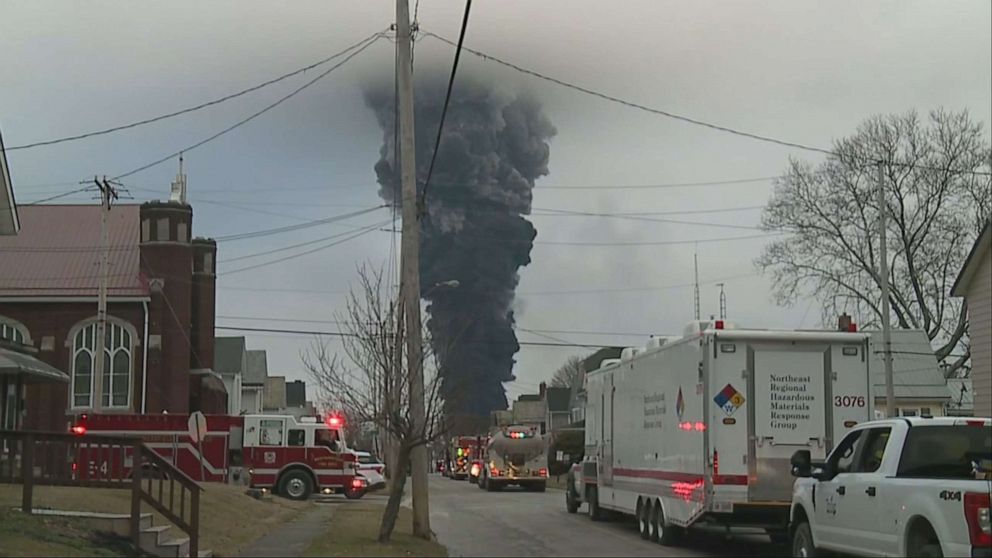Ohio Derailment's Aftermath: Persistent Toxic Chemicals In Buildings

Table of Contents
Pathways of Chemical Contamination in Buildings
The release of vinyl chloride and other toxic chemicals during the Ohio train derailment created multiple pathways for contamination to enter buildings. Understanding these pathways is crucial to assessing the extent of the risk and developing effective remediation strategies.
-
Air Infiltration: Volatile organic compounds (VOCs), like vinyl chloride, easily infiltrated buildings through cracks in walls, windows, and around doors. Poorly sealed ventilation systems also facilitated the entry of these airborne contaminants into homes and other structures. The prevailing wind patterns at the time of the derailment significantly influenced the spread of these chemicals, leading to varying levels of contamination across the affected area.
-
Particulate Matter Deposition: The burning of vinyl chloride and other chemicals released a significant amount of particulate matter, which settled as dust on surfaces within buildings. This dust can contain persistent toxic chemicals, posing a risk through inhalation or dermal contact. The accumulation of this contaminated dust on furniture, floors, and other surfaces presents a significant cleaning and remediation challenge.
-
Absorption into Building Materials: Many building materials, especially porous ones such as drywall, carpeting, and fabrics, can absorb volatile organic compounds. This absorption process can lead to the slow release of these chemicals over time, resulting in prolonged exposure for residents. The extent of absorption depends on the porosity of the material and the concentration of the chemicals.
-
Groundwater Contamination: The derailment also led to the contamination of groundwater, which may infiltrate basements and foundations of buildings. This poses a significant risk of exposure through contact with contaminated water and potential vapor intrusion.
Health Risks Associated with Long-Term Exposure
Prolonged exposure to the chemicals released during the Ohio train derailment, particularly vinyl chloride, poses significant health risks. The long-term effects of exposure can be severe and may not manifest immediately.
-
Cancer Risks: Vinyl chloride is a known human carcinogen, increasing the risk of leukemia, liver cancer, and other cancers. The latency period for cancer development can be decades, highlighting the need for long-term health monitoring of affected residents.
-
Respiratory Problems: Exposure to various chemicals released during the derailment can cause or exacerbate respiratory problems such as asthma, bronchitis, and other lung diseases. The inhalation of particulate matter and VOCs contributes to these respiratory issues.
-
Neurological Disorders: Some of the chemicals released are neurotoxins, potentially causing headaches, dizziness, cognitive impairment, and other neurological disorders. Long-term exposure to these neurotoxins can lead to more serious and lasting effects.
-
Reproductive Health Issues: Certain chemicals released during the derailment are known to affect reproductive health, potentially leading to infertility, birth defects, and other complications. Further research is needed to fully understand the long-term reproductive health impacts on the exposed population.
Challenges in Detecting and Removing Persistent Chemicals
Identifying and remediating the contamination in buildings following the Ohio train derailment presents significant challenges. The complexity of the contamination and the lack of standardized protocols hinder effective cleanup efforts.
-
Lack of Standardized Testing Protocols: The absence of consistent and standardized testing protocols for all the released chemicals in building materials makes comprehensive assessment difficult. This makes it challenging to establish a baseline for contamination and track the effectiveness of remediation efforts.
-
Difficulty in Accessing and Testing Buildings: Effectively assessing the extent of contamination requires access to all potentially affected buildings, which can be challenging due to logistical and property access limitations.
-
High Cost of Remediation: Comprehensive testing and remediation of building materials are costly, potentially placing an undue financial burden on affected residents and the government. The expense of specialized equipment and expertise further contributes to this challenge.
-
Efficacy of Decontamination Methods: Debate exists regarding the efficacy of various decontamination methods. The choice of remediation strategy must consider the specific chemicals involved, the materials affected, and the potential for secondary contamination.
Ongoing Cleanup Efforts and Government Response
Government agencies and private companies are undertaking cleanup efforts, but the adequacy of these efforts in addressing building contamination remains a point of contention.
-
Government Funding and Resource Allocation: The level of government funding and resource allocation dedicated to building decontamination is crucial for effective remediation. Ensuring sufficient funding and resources is essential for carrying out comprehensive testing and implementing appropriate cleanup strategies.
-
Role of Environmental Agencies: Environmental agencies play a critical role in overseeing the cleanup process, ensuring adherence to safety standards and environmental regulations. Their oversight is essential to ensuring the protection of public health and the environment.
-
Public Health Initiatives: Public health initiatives, including health screenings and monitoring programs, are essential to assess the long-term health effects of the derailment and provide support to affected residents.
-
Transparency and Communication: Open and transparent communication regarding the cleanup progress and the associated health risks is crucial to building public trust and ensuring the cooperation of residents. Legal implications and potential lawsuits are likely to arise from the long-term health consequences of the derailment.
Conclusion
The Ohio train derailment's legacy extends beyond the immediate disaster zone. The persistent presence of toxic chemicals in buildings presents a significant long-term health risk to residents of East Palestine and surrounding areas. Effective and comprehensive cleanup efforts are crucial, coupled with robust health monitoring programs to mitigate the potential health consequences. The lack of standardized testing and remediation strategies poses a major challenge, highlighting the urgent need for improved protocols and increased government support.
Call to Action: To ensure the safety and well-being of communities affected by the Ohio train derailment, continued vigilance and transparent communication regarding the lingering threat of persistent toxic chemicals in buildings is paramount. Demand further investigation into the long-term effects and support policies that prioritize the health and safety of those affected by this devastating event. Learn more about the ongoing efforts to address the pervasive issue of persistent toxic chemicals in buildings post-derailment and demand accountability for those responsible.

Featured Posts
-
 Red Sox Vs Blue Jays Game Preview Lineups Buehler And Outfielder Update
Apr 28, 2025
Red Sox Vs Blue Jays Game Preview Lineups Buehler And Outfielder Update
Apr 28, 2025 -
 Are You In A Silent Divorce Identifying The Key Indicators
Apr 28, 2025
Are You In A Silent Divorce Identifying The Key Indicators
Apr 28, 2025 -
 The Luigi Mangione Phenomenon Understanding His Supporters
Apr 28, 2025
The Luigi Mangione Phenomenon Understanding His Supporters
Apr 28, 2025 -
 Dealers Double Down Fighting Back Against Ev Sales Requirements
Apr 28, 2025
Dealers Double Down Fighting Back Against Ev Sales Requirements
Apr 28, 2025 -
 New Sponsor Joins Bubba Wallace At 23 Xi Racing
Apr 28, 2025
New Sponsor Joins Bubba Wallace At 23 Xi Racing
Apr 28, 2025
Latest Posts
-
 Phoenix Nascar Race Bubba Wallace Involved In Crash Due To Brake Failure
Apr 28, 2025
Phoenix Nascar Race Bubba Wallace Involved In Crash Due To Brake Failure
Apr 28, 2025 -
 Brake Problems Cause Bubba Wallace To Crash At Nascar Phoenix Race
Apr 28, 2025
Brake Problems Cause Bubba Wallace To Crash At Nascar Phoenix Race
Apr 28, 2025 -
 Bubba Wallaces Brake Issue Leads To Wall Collision At Phoenix Raceway
Apr 28, 2025
Bubba Wallaces Brake Issue Leads To Wall Collision At Phoenix Raceway
Apr 28, 2025 -
 Nascar Phoenix Bubba Wallace Suffers Brake Failure Crashes
Apr 28, 2025
Nascar Phoenix Bubba Wallace Suffers Brake Failure Crashes
Apr 28, 2025 -
 Bubba Wallaces Phoenix Crash Brake Failure Causes Wall Impact
Apr 28, 2025
Bubba Wallaces Phoenix Crash Brake Failure Causes Wall Impact
Apr 28, 2025
